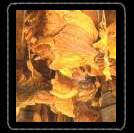Canada's Digital Collections - Home - People -
Museum - Sources - Feedback
- Glossary
Beginnings - Lheidli T'enneh -
Meeting of Two Cultures - The
Pioneer Experience
Berry Picking - Building a
Dwelling - Fishing - Salmon
–18 feet in length and 12–15 feet in circumference. This dam/basket system was called a salmon weir and could catch up to 1,000 salmon a day. The Lheidli T'enneh used several different types of weirs and traps. One type could be used for fish, beaver or muskrat (Klippenstein).Let's go fishing. Be prepared to bring home not just one or two fish, but almost 1,000! With Carrier fishing technology we could bring home enough fish to help feed the whole community for months!
For hundreds, and most likely thousands of years before they made any contact with the white man, the Carrier were a people who moved and harvested according to the seasons. Salmon were a large part of the Carrier's diet, and so intricate technology was developed to help in the yearly salmon catch. Salmon fishing was done in the summer when a dam would be made across the river into which baskets or nets could be inserted. These baskets were very large: 15
As salmon were a major part of the Lheidli T'enneh's diet they were sure to let enough salmon escape and spawn.
"Many years ago the Natives gathered in Shin to set their weirs in the river. They caught and dried large numbers of fish, while the children played happily around the camp. Then a boy named Mek made a girdle of some fish heads and began to dance with them. An old man scolded him saying, 'Don’t do that. Sa will see you and by and by you will be hungry!' A year passed, and the people gathered again at the same spot, but this time they caught no fish at all. The men left the women to attend the net and went away to hunt, but the game too had vanished. Before long they were starving and the first to die was Mek. No sooner was he dead than the river seemed to teem with fish and the people had no difficulty in catching all they needed" (Jenness).
Most of the salmon was dried and thus could keep for years. Once the basket was filled with salmon, it was brought to shore, where the women of the village would remove the entrails and hang the fish by their tails in the open air. After a day or two the fish were taken down and cut into thin strips, then left to hang for one month. When the fish were entirely dry they were put into storehouses. These storehouses were built ten feet from the ground in order to protect the salmon stock from wild animals (Harmon quoted in Klippenstein).
The yearly salmon catch was a community effort. Everyone who set a trap in the stream needed to contribute his share of labour toward erecting the weir (Klippenstein). When the salmon were late in coming, the Dayun'un was asked to summon the fish up river. Singing and dancing a medicine song, he would shake his rattle asking for salmon to come. When salmon failed, village groups sought assistance from other groups in adjacent watersheds (Klippenstein).
Although sockeye salmon was extremely important to Carrier subsistence, other fish were also necessary for survival. Gas are also taken from the river, but are not as favoured, as they do not taste as good or preserve as well as sockeye salmon. The Carrier also took freshwater fish for their stocks, and these included: Bit; Tsabai; Dakai; Toh; and Tohco.

Berry Picking - Building a Dwelling - Fishing
- Salmon
Beginnings - Lheidli T'enneh
- Meeting of Two Cultures - The Pioneer Experience
Canada's Digital Collections -
Home - People
- Museum - Sources - Feedback
- Glossary